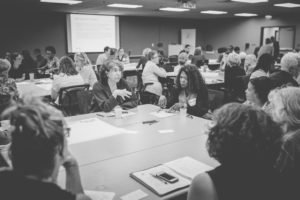
Courtesy of City of Philadelphia, JPG Photography
We’ve all been in a meeting and realized everyone there is having a different conversation. We’ve all been in a meeting with people we do not like, or worse, don’t trust. That’s why Strategy Arts establishes meeting guidelines that frame conversations and support trust-building. During the introduction of each meeting, we articulate the guidelines and leave them posted near the front of the room. Recently, we met with a leadership group who demonstrated the power of using our collective impact meeting guidelines to support collaborative conversations.
Here is how they leveraged the guidelines:
1. Maintain confidentiality – no names shared, no data shared outside the room.
Working within collective impact often requires nonprofits that compete for funding to collaborate so they can drive systems-level change. Gaining agreement on the importance of confidentiality allows people to speak freely about the shortfalls of their own organization. They can also seek help filling the gaps from other members of the initiative.
During this meeting, a participant made an important suggestion to the group, “share what you can, and acknowledge what you can’t.” Every organization has some restrictions on what they can feel like they can share, but being honest about your boundaries, rather than appearing evasive, helps to build trust.
2. Assume positive intent.
In addition to maintaining confidentiality, meeting participants sometimes need a reminder that everyone in the room cares about the issue at hand, and wants to work together to address it.
In this meeting, we took a few moments to ensure that each participant still agreed with the vision of the future and purpose of the initiative articulated in the Common Agenda. Everyone agreed they were aligned, even if they sometimes disagree about the best approach for reaching the goals. That brief activity helped the group pause and reflect on their purpose. For the rest of the meeting, the group modeled assuming positive intent towards meeting the Common Agenda in all their conversations. We began to see them move past some historic tensions and coalesce around their purpose.
3. Be okay with not having all the answers.
A key component of collective impact is learning from all stakeholders and applying those learnings to improve your own practice.
One work group chair shared that they were changing their implementation of a national curriculum based on something they learned from others in the collective. They could already see the possibilities of improving their service by integrating a new stakeholder into their work. Their confidence in the new approach was so strong, they were exploring how to reach out to the curriculum developer and suggest a nationwide adjustment to the program. It took the organization being open to change—and willing to share they hadn’t been doing it as well as they could have—to make that change happen.
In our meeting, they also admitted they needed help from others in the room to improve their work. That vulnerability provided the group with a sense of purpose (sharing their knowledge), and served as a compliment.
4. Test assumptions, seek to understand.
All of us have been in a conversation where we understand a person’s words, but make a leap to what we think they mean. This guideline encourages participants to understand what is happening underneath spoken comments.
Participants in our meeting asked difficult questions about funding in a respectful way that gave the agency space to explain their decision-making process. Several other organizations then shared they might be able to raise some funds to ensure an effective, well-supported initiative. Without an open dialogue, some partners may have been frustrated that their priorities were not fully funded, but not understanding the backbone agencies’ limitations.
Collaboration Requires Authentic Relationships
Bringing together organizations forming a collective impact initiative is difficult. When those organizations have a complicated history, it can be even more challenging. We are always aware of the importance of relationships, professional and personal, in making collaborative work more successful. Without authentic, relationships, collaborations won’t take the risks they need to address the hard challenges facing them. Following these guidelines helps create those relationships by building understanding, sharing knowledge freely, creating a space to be vulnerable, and assuming that the people in the room are there to support the work.

